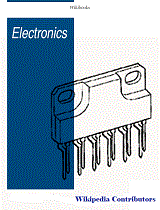
|
FreeComputerBooks.com
Links to Free Computer, Mathematics, Technical Books all over the World
|
|
- Title An Introduction to Electronics
- Author(s) Wikipedia Contributors
- Publisher: WikiBooks
- License(s): CC BY-SA 3.0
- Paperback: N/A
- eBook: HTML and PDF (401 pages)
- Language: English
- ISBN-10: N/A
- ISBN-13: N/A
- Share This:

|
The aim of this book is to explain the design and function of electronic circuits and components. It covers electronic circuit components, DC analysis, and AC analysis, and provides readers with a broad overview of both the linear and digital fields of electronics while also providing the basics so they can understand the fundamentals of electronics.
It book is intended for first year students or users to stimulate their interest in electronics, whether they are in high school, college or the field, and will provide them with a fundamental background in electronics that they need to succeed in today's increasingly digital world. It continues to expose readers to the broad field of electronics at a level that they can easily understand.
It should be useful to beginner hobbyists as well as beginner engineering students, teaching both theory and practical applications.
It should be thought of as a companion project to the Wikipedia articles about electronics. While Wikipedia covers many details about the technology used in electronics components and related fields, the Electronics Wikibook covers a lot of the ”how-to” aspects that aren’t covered in an encyclopedia. The book will focus on how to use the components to build useful circuits.
About the Authors- N/A
- Electronic Engineering
- Microcontrollers, PLC, VLSI, etc.
- Embedded Systems
- Electrical and Computer Engineering
 Similar Books:
Similar Books:
-
 Semiconductor Devices: Theory and Application (James M. Fiore)
Semiconductor Devices: Theory and Application (James M. Fiore)
Covers the theory and application of discrete semiconductor devices including various types of diodes, bipolar junction transistors, JFETs, MOSFETs and IGBTs. Applications include rectifying, clipping, clamping, switching, small signal amplifiers and followers.
-
 Understanding Electronics Components (Filipovic D. Miomir)
Understanding Electronics Components (Filipovic D. Miomir)
This book is meant for those people who want to create electronic devices with their own hands. All components are illustrated and the circuit-symbol is explained in detail. Both simple and complex examples are provided for the beginners.
-
 Lessons in Electric Circuits (Tony R. Kuphaldt)
Lessons in Electric Circuits (Tony R. Kuphaldt)
A 6 volumes series of textbooks on the subjects of electricity and electronics. This book was written to be a good enough book without delving too heavy on the math, while still maintaining a lot of important information.
-
 Mastering STM32 (Carmine Noviello)
Mastering STM32 (Carmine Noviello)
This book introduces the reader to this exciting MCU portfolio from ST Microelectronics and its official CubeHAL, showing its functionalities with a lot of examples and tutorials, assumes that you are totally new to this family of MCUs.
-
 Compact Models for Integrated Circuit Design
Compact Models for Integrated Circuit Design
This book provides a modern treatise on compact models for circuit computer-aided design (CAD), offers a balanced presentation of compact modeling crucial for addressing current modeling challenges and understanding new models for emerging devices.
-
 Network-on-Chip: The Next Generation of System-on-Chip
Network-on-Chip: The Next Generation of System-on-Chip
This book provides a basic overview of topics associated with NoC-based design: communication infrastructure design, communication methodology, evaluation framework, and mapping of applications onto NoC.
-
 Flexible Circuit Technology (Joseph Fjelstad)
Flexible Circuit Technology (Joseph Fjelstad)
This book was written to provide a bridge of understanding by offering a clearly defined set of steps which take the reader from basic concepts of flexible circuits to a more detailed review of the various technology and materials.
-
 Designing Analog Chips (Hans Camenzind)
Designing Analog Chips (Hans Camenzind)
A comprehensive introduction to CMOS and bipolar analog IC design. The book presumes no prior knowledge of linear design, making it comprehensible to engineers with a non-analog background.
-
 Operational Amplifiers and Linear Integrated Circuits
Operational Amplifiers and Linear Integrated Circuits
This book offers an extensive and detailed exploration of the modern op amp and associated specialized linear integrated circuits. The exploration begins with a fundamental building building block, the differential amplifier.
-
 A Pragmatic Introduction to the Art of Electrical Engineering
A Pragmatic Introduction to the Art of Electrical Engineering
This book provides a solid overview of the electrical engineering discipline that is especially geared toward the many non-electrical engineering students. It uses of practical applications to illustrate important principles.
-
 Circuit Theory (WikiBooks)
Circuit Theory (WikiBooks)
The aim of this book is to assist students in understanding the basic concepts of circuit theory and developing the fundamental tools of linear circuit analysis, which will be useful for all engineers.
-
 AC Circuits (Chad Davis)
AC Circuits (Chad Davis)
This book covers Alternating Current (AC) circuit theory as well us a brief introduction of electronics. It covers the basic theory of AC signals, sinusoidal waveforms, square waves, triangle waves, the mathematics background, resistors, inductors, and capacitors.
-
 DC Circuits (Chad Davis)
DC Circuits (Chad Davis)
This book covers Direct Current (DC) circuit theory: The basics for circuits that include DC sources (voltage or current) and resistors; Problem solving techniques for circuits that include only DC sources and resistors; Capacitors and inductors.





